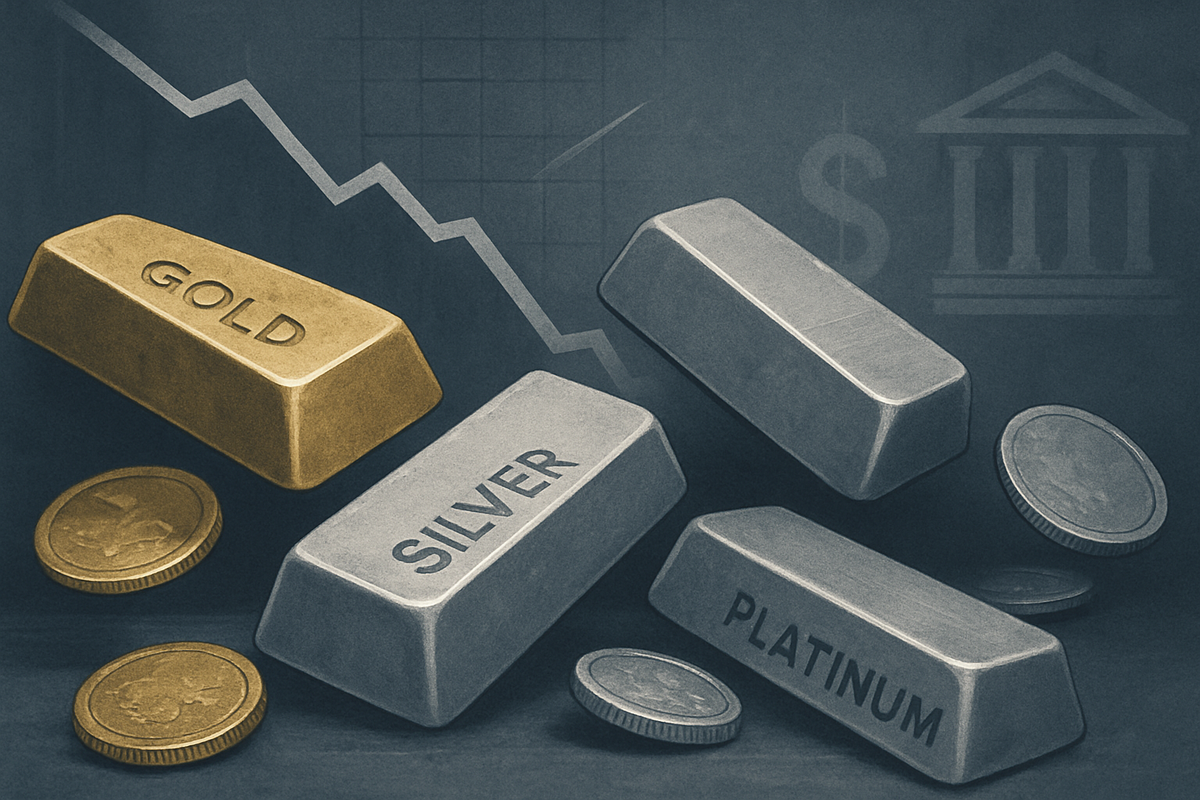
The global precious metals market experienced a significant downturn on Friday, November 14, 2025, as gold, silver, and platinum registered a broad sell-off and substantial price pullbacks. Gold, a traditional safe-haven asset, tumbled towards the critical $4100 level, marking a notable shift in market sentiment and prompting investors to reassess their positions. This widespread retreat across the precious metals complex has sent ripples through financial markets, raising questions about the immediate future of these historically stable commodities.
The immediate implications of this sell-off are a palpable increase in market volatility and a re-evaluation of investment strategies. While some analysts view this as a healthy correction within a larger bullish trend, others are expressing caution, particularly given the confluence of factors that triggered the decline. The sudden depreciation underscores the sensitivity of these markets to macroeconomic signals and investor confidence, setting the stage for a period of heightened scrutiny and potential strategic adjustments by market participants.
Unpacking the Downturn: A Deep Dive into the Precious Metals Rout
The significant sell-off in precious metals on November 14, 2025, saw gold prices plummet to as low as $4,034.54 per ounce in early trading, with the New York Spot Price settling at $4,065.80 per ounce, a drop of $104.50 or 2.51%. December gold futures similarly fell by $75.50 to $4,119.00. This sharp decline followed a period where gold had reached a one-month high of $4,244 on Thursday and an October peak near $4,400, making the pullback particularly jarring for investors. Silver, known for its higher volatility, bore an even greater brunt, dropping $1.68 or 3.21% to a New York Spot Price of $50.53 per ounce, with futures falling over 4.5% to $50.70. Platinum also registered a significant decline of 2.8%, settling at $1,569.
The primary catalyst for this widespread retreat was a series of hawkish comments from U.S. Federal Reserve officials. These remarks effectively dampened market expectations for imminent interest rate cuts, pushing back the narrative of an easing cycle that had previously supported precious metals prices. Federal Reserve Chairman Jerome Powell had previously indicated that "another interest rate cut in December is 'not on the cards'," a sentiment echoed by other Fed officials who suggested policy should remain "somewhat restrictive." This shift in rhetoric led to a significant reduction in the perceived probability of a December rate cut, with CME Group's FedWatch tool showing a drop from 63% on November 12 to around 50-51% by November 14.
Adding to the pressure, market expert Jim Wyckoff highlighted "aggressive profit-taking" and "widespread long liquidation" among shorter-term futures traders. This profit-taking spree, combined with the broader "risk-off" sentiment pervading global markets—evidenced by declines in global stocks, bonds, and even cryptocurrencies (particularly after a steep sell-off in the USA's AI 'bubble')—exacerbated the downward momentum. The recent reopening of the U.S. government, following a prolonged shutdown, also contributed to a perceived reduction in the need for safe-haven assets, further pressuring gold. The uncertainty stemming from delayed economic data releases during the shutdown left investors "guessing," adding another layer of trepidation to the market.
Winners and Losers: Corporate Impact of the Precious Metals Sell-Off
The recent broad sell-off in gold, silver, and platinum markets is poised to create a distinct divide between winners and losers within the public company landscape, particularly impacting mining companies, precious metals dealers, and investment funds. Mining companies, whose profitability is directly tied to commodity prices, are likely to face immediate headwinds. Major gold producers like Barrick Gold Corporation (NYSE: GOLD) and Newmont Corporation (NYSE: NEM) will see their revenue forecasts and profit margins compressed by lower gold prices. Similarly, companies with significant silver or platinum operations, such as Pan American Silver Corp. (NASDAQ: PAAS) or Sibanye-Stillwater Limited (NYSE: SBSW), will feel the pinch, potentially leading to revised production guidance and capital expenditure reviews.
Conversely, some entities may find themselves in a more favorable position. Industrial consumers of silver and platinum, such as electronics manufacturers (e.g., Apple Inc. (NASDAQ: AAPL) uses silver in some components) or automotive catalytic converter producers (e.g., Johnson Matthey PLC (LSE: JMAT) for platinum group metals), could benefit from lower input costs. This reduction in raw material expenses could boost their profit margins, provided demand for their end products remains stable. Additionally, investors with short positions in precious metals or those holding cash to buy on the dip might emerge as short-term winners, capitalizing on the market's downward momentum or accumulating assets at a lower cost.
The impact extends beyond direct producers and consumers. Exchange-Traded Funds (ETFs) that track precious metals, such as SPDR Gold Shares (NYSEARCA: GLD) or iShares Silver Trust (NYSEARCA: SLV), will see their net asset values decline, affecting investors holding these instruments. While this represents a loss for current holders, it could present a buying opportunity for long-term investors looking to average down their costs or initiate new positions at a lower entry point. The broader financial services sector, including banks and brokerages, might experience increased trading volumes due to heightened volatility, potentially offsetting some of the negative sentiment. However, their exposure to mining company loans or precious metals-backed derivatives could also expose them to risk if the downturn persists.
Wider Significance: A Shift in Market Dynamics
The recent precious metals sell-off transcends mere price adjustments; it signifies a potential shift in broader market dynamics and investor psychology. This event fits into a larger trend where traditional safe-haven assets are increasingly influenced by monetary policy expectations, particularly from the U.S. Federal Reserve. The hawkish stance by the Fed, signaling a potential delay in interest rate cuts, underscores the growing dominance of interest rate differentials and opportunity costs in investment decisions. When yields on less risky assets like U.S. Treasuries become more attractive, the appeal of non-yielding assets like gold diminishes, challenging its conventional role as an ultimate store of value during uncertainty.
The ripple effects of this downturn are likely to be felt across various sectors. Competitors in the investment space, such as bond markets and even certain segments of the equity market (e.g., dividend-paying stocks), may see increased inflows as investors seek alternatives to precious metals. Partners in the mining and refining industries will also face adjustments, potentially leading to renegotiated contracts or a slowdown in expansion projects. Regulatory implications could emerge if the volatility prompts calls for greater transparency or oversight in futures markets, although this is a longer-term prospect. Historically, similar sharp corrections in precious metals have often been tied to shifts in central bank policy or periods of strong economic growth that reduce the need for safe havens. The current situation bears resemblance to periods where rising real interest rates have pressured gold, suggesting that a sustained hawkish Fed stance could prolong the subdued performance of precious metals.
This event also highlights the interconnectedness of global financial markets. The broader "risk-off" environment, encompassing declines in stocks, bonds, and even cryptocurrencies, indicates a systemic re-evaluation of risk across asset classes. This interconnectedness means that a sustained downturn in precious metals could signal deeper anxieties within the financial system, potentially leading to further deleveraging and a flight to liquidity. The muted response of gold to the equity pullback, as noted by some analysts, further raises questions about its reliability as a hedge in all market conditions, challenging long-held investment tenets and potentially prompting a re-evaluation of portfolio diversification strategies.
What Comes Next: Navigating the Precious Metals Landscape
Looking ahead, the precious metals market faces a period of heightened uncertainty and potential re-calibration. In the short term, the market is likely to remain highly sensitive to further communications from the U.S. Federal Reserve. Any indications of a sustained hawkish stance or further delays in anticipated rate cuts could exert continued downward pressure on gold, silver, and platinum. Conversely, any dovish pivot or renewed concerns about economic stability could trigger a rebound as investors flock back to safe-haven assets. Traders will be closely watching economic data releases, particularly inflation figures and employment reports, for clues on the Fed's future direction.
In the long term, the outlook for precious metals will depend on a confluence of factors, including global economic growth, geopolitical stability, and the trajectory of inflation. Should inflation remain elevated, precious metals could regain their appeal as an inflation hedge, albeit with a lag. However, a strong global economic recovery coupled with rising real interest rates could limit their upside. Potential strategic pivots for investors might involve diversifying within the commodities space, exploring other inflation-hedging assets, or adopting a more tactical approach to precious metals, buying on dips rather than holding for passive appreciation. Mining companies may need to adapt by focusing on cost efficiencies and optimizing production to navigate periods of lower commodity prices.
Market opportunities could emerge for contrarian investors who believe the current sell-off is an overreaction and that the long-term fundamentals for precious metals remain intact. The significant pullback could present an attractive entry point for those with a long-term bullish outlook, particularly for silver, which many observers still view as experiencing a "healthy correction" and a "fresh buying opportunity." Challenges will include managing volatility, accurately predicting central bank actions, and discerning genuine trend reversals from temporary corrections. Potential scenarios range from a rapid rebound if the Fed signals a more accommodary stance, to a prolonged period of consolidation if interest rates remain high, or even further declines if economic data strengthens significantly, reducing the need for safe havens.
Comprehensive Wrap-Up: A Crossroads for Precious Metals
The recent broad sell-off in gold, silver, and platinum markets marks a critical juncture for these traditional safe-haven assets. The key takeaway is the profound influence of U.S. Federal Reserve policy, with hawkish remarks effectively resetting market expectations for interest rate cuts and triggering aggressive profit-taking. Gold's pullback towards the $4100 level, alongside significant declines in silver and platinum, underscores the market's sensitivity to monetary policy signals and the broader "risk-off" sentiment that has gripped global financial markets. This event challenges the perception of precious metals as an infallible hedge, particularly when real interest rates are expected to remain elevated.
Moving forward, the market for precious metals will likely be characterized by increased volatility and a more nuanced relationship with macroeconomic indicators. Investors should prepare for a period where central bank rhetoric, inflation data, and geopolitical developments will play an outsized role in price movements. While some analysts maintain a bullish long-term outlook, viewing the current dip as a buying opportunity, the immediate future hinges on the Fed's next moves and the global economic response. The interconnectedness of asset classes means that a sustained weakness in precious metals could signal broader systemic concerns, prompting a re-evaluation of portfolio diversification strategies.
The lasting impact of this sell-off could be a recalibration of investor expectations regarding precious metals' role in a diversified portfolio. What investors should watch for in the coming months includes any shift in the Federal Reserve's stance, the trajectory of global inflation, and the performance of other asset classes, particularly bonds and equities. The ability of gold, silver, and platinum to regain their upward momentum will depend on whether the underlying drivers of their recent strength—such as inflation concerns and geopolitical instability—reassert themselves with enough force to overcome the headwinds of higher interest rates and a stronger dollar.
This content is intended for informational purposes only and is not financial advice


















